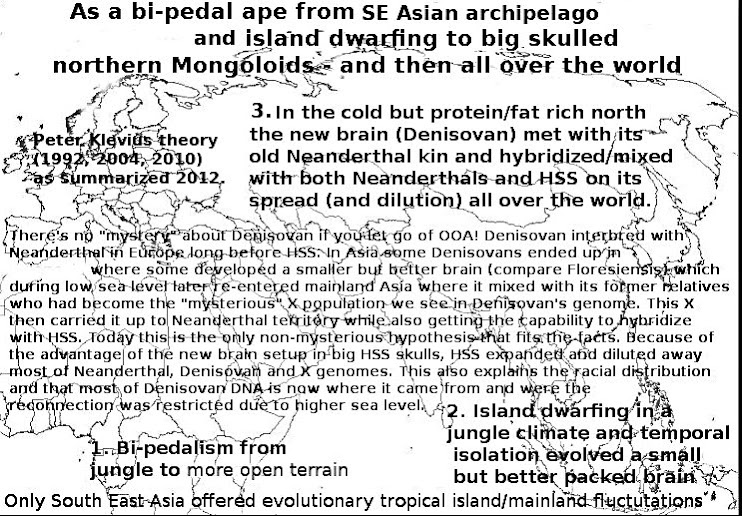A thorough throw paved the way down from the trees
Although more upright standing in the trees started the development of hands, what really made a difference was the capability to throw stones to scare predators away. This led to cracking rocks in amaller pieces which was the first step towards s.c. stone tool technologies.
How come that only Peter Klevius has come forward with this selfevident theory (Wikipedia doesn't know of such a theory on its 'bipedalism' page).
Don't forget citation, dude!
Peter Klevius wrote:
Wednesday, June 26, 2019
Why Africa was impossible and SE Asia necessary for human evolution

Peter Klevius simple evolution tutorial for simple minds - e.g. ignorant anthropology professors etc.
Peter Klevius evolution formula, first published as an article 1981 and as a book 1992 (ISBN9173288411) and on the web 2004, 2008, 20010, 2012. Do note that those who didn''t hybridize resulted in the fossile diversity that has puzzled som amny an anthropologist. Also consider that Peter Klevius general evolution formula (first published 1981) covers everything including the fractured oceans(s) that led to diversity after the cambrian explosion and extinction.
Peter Klevius annoying habit of repeating Peter Klevius, and his self citations, isn't a neural defect but has to be evaluated against the very thick wall* between him and Harvard, Stanford etc., which makes his existence almost invisible. Not to mention the enormous moat* concisting of "spiritualists", creationalists, religionists, alienists, conspirationalists etc.
* 'Wall' and 'moat' come from old Swedish words still in use today, i.e. 'vall' and 'mot'. Don't trust fake etymology - trust Peter Klevius who would be extremely embarrassed if he were proven wrong.
Peter Klevius evolution formula (published 1981, 1992): Isolation-fluctuation* and hybridization. There's no difference between the evolution of Universe and the Sun and its surrounding, or the evolution of "life". We lack a coherent definition of "life" and will never get one. However, comfort yourself with Peter Klevius 'existence-centrism' and UN's negative Universal Human Rights.
* No dude, there's no "extinction" other than the one you use practically in Wittgenstein's language game. If the dinosaurs haven't disappeared then why would the hominies.Peter Klevius' appeal for the understanding of the disability concisting of how a super high IQ combined with a flawless hormone/dopamine/serotonine balance* makes him the "extremely normal" whom no one really likes - except for those who know him 100% longterm and have survived their annoyance of own shortcomings mirrored in his disability. So Peter Klevius "bragging" about himself is easily outweighed by his disability - if this fact may comfort you. After all, intelligencephobia is so PC that the only intelligence that is possible, i.e. the individual one, is denied while the oxymoron "group intelligence" is hailed. Peter Klevius + 9 half idiots would have an average IQ as a group - so what?!
* If you get annoyed while reading this, then ask yourself if you would be equally annoyed when reading about the qualities of a sports star, an actor/actress, a singer etc. See my point?
However, unlike you, Peter Klevius also suffers from the ethical dilemma of sitting silent and have peace while clearly understanding he has something to offer. And pretending to be "humble" would only diffuse him into the realm of easily dismissed (from whatever direction at whatever time and subject) opinionaters.
Peter Klevius on cosmology, first in an article (1981) and later unchanged in Demand for Resources (1992:23, ISBN 9173288411):
'The basis of existence is motion/change, and causality constitutes a complex of evolution and devolution. Evolution may be seen as the consequence of causality's variables in time where complexity in existing structures are regenerated. This stands in opposition to thermodynamics which theoretically leads to maximal entropy (i.e. equilibrium) where time/change ultimately would end. Someone might then say that the products of evolution are just temporary components in causality's road towards uniformity.'(Klevius 1992:23). An example of evolution and devolution is a star cycle ending in a super nova - incl. everything in it.
A lump in a nebula is the "island" on which a star is born.
1. Peter Klevius concept 'existence-centrism' (1992) is the only way to understand and handle the traps for logic that language creates. Existence-centrism is the immutable truth that we can't sidestep. All your (or humankind's) collected experience at every single moment limits what you can say. And as a consequence, metaphysical statements are either impossible or just "meta-metaphysical".
2. The formation of structure not only rests on previous structure but is the very evidence for it.
The evolution of life may be described as based on strong fluctuations (isolation) and weak fluctuations (hybridization).
Speciation needs isolation. After migration hybridization
stops further speciation and explains fossil diversity
as well as existing phenotypes.
Human evolution in retrospective is a repeated chain of
speciation and hybridization.
Different types of life depend on different types of isolation and fluctuation.
Early hominines (before more advanced use of tools) were not specialized to really anything except bi-pedalism, but could do a little and eat a little of almost everything. This made them moving around in a way that excludes isolation other than on islands.
Therefore "part time islands" constitute the best evolutionary labs.
And SE Asia is the perfect cradle which has had a longterm and varied hiatory of island/mainland fluctuations incl. between islands.
Peter Klevius wrote:
Thursday, March 15, 2012
The Red Deer Cave people add more evidence for Klevius’ ape/homo hybridization theory
The irrefutable art track in Northern Eurasia (see map below) has no contemporary equivalent in other parts of the world. Based on what we know now it had no fore bearers whatsoever in any period of time. Moreover, it seems that there was even a decline before "civilizations" started tens of thousands of years later! Yet Klevius seems to be the only one addressing this most interesting (besides genetics) fact! According to Klevius (and no one else so far) the new and more efficient brain evolved in a jungle environment (SE Asia?) and spread up until meeting with big headed Neanderthals hence creating the modern human who later spread and dissolved with archaic homos. In this process Homo erectus was most probably involved as well.
Updated info about the origin of Klevius' theory
Keep in mind that mainland SE Asia possibly harbored physically truly modern humans already before the time range (50,000 ybp - 98,000 ybp) of the Homo floresiensis remains in the Flores cave.Liujiang, SE China (est. 100,000-140,000ybp)
If this Liujiang skull had been found in Africa or Mideast Wikipedia and other media would be overfilled. But this is all you get now (summer 2015 update) from Wikipedia about this extremely important skull:
The Liujiang skull probably came from sediment dating to 111 000 to 139 000 which would mean it's older than the oldest Homo floresiensis remains on Flores. Nothing even remotely close to this modern skull has ever been found in Africa, Mideast or Europe this early. In other words, we have the extremely archaic looking Red Deer Cave people 100,000 years after this extremely modern looking Liujiang population at approximately the same region. Even the least probable estimate of 70,000 bp would make Liujiang more modern looking than anything else.
Also compare Lake Mungo remains in Australia with an mtDNA that differs completely from ours (incl. Australian Aborigines). Sadly the remains have been kept out of further research (which fact came handy for those who want to dismiss it) because of stupid* "Aboriginal"(?!) greed (for the purpose of making certain people more "special" than others for no good reason at all (also compare the ridiculous Kennewick man controversy). Does it need to be said that the Mungo remains are as far from Australian Aborigines in appearance as you can imagine. However, according to Alan Thorne, 'Mungo could not have come from Africa as, just like Aboriginal Australians don't look like anybody from Africa, Mungo Man's skeleton doesn't look like anybody from Africa either. LM3 skeleton was of a gracile individual, estimated stature of 196 cm, which all sharply contrast with the morphology of modern "indigenous" Australians. Compared to the older Liujiang skull Mungo man had a much smaller brain.
* There's no way anyone can state who was "first" in Australia - and even if there was, then there's still no way of making any meaningful connection to now living people.
Peter Klevius 1992-2010: From tropical SE-Asia to cold and protein/fat rich North Eurasia to global humans. In Demand for Resources (1992 ISBN 9173288411) Klevius not only set the foundation of the so far best theory on consciousness and how the brain works (see e.g. the "stone" example pp 31-33, or the 1994 EMAH paper that was sent to Francis Crick ), but also connected the big brained 280,000 bp Jinniushan in northern China with the mongoloid features of the oldest Africans - and asked: Why didn't Jinniushan people go to the Moon, after all, they had several iceages time to do so with a brain size exceeding modern humans. In 2004, after the discovery of Homo floresiensis Klevius immediately told the world that here was the "missing brain link". When six years later Denisovan was found, Klevius theory was proven correct in everything except lesser details.
Most "mysteries" in genetics disappear by abandoning OOA and changing direction of HSS evolution. Only South East Asia offered a combination of tropical island/mainland fluctuations needed to put pressure on size reduction paired with evolutionary isolation in an environment where only those survived who managed to shrink their heads while keeping the same intelligence as their mainland kins with some double the sized brain. Homo floresiensis is evidence that such has happened there.
Denisovan is an extinct species of human in the genus Homo. In March 2010, scientists announced the discovery of a finger bone fragment of a juvenile female who lived about 41,000 years ago, found in the remote Denisova Cave in the Altai Mountains in Siberia, a cave which has also been inhabited by Neanderthals and modern humans. Two teeth and a toe bone belonging to different members of the same population have since been reported.
Analysis of the mitochondrial DNA (mtDNA) of the Denisovan finger bone showed it to be genetically distinct from the mtDNAs of Neanderthals and modern humans. Subsequent study of the nuclear genome from this specimen suggests that this group shares a common origin with Neanderthals, that they ranged from Siberia to Southeast Asia, and that they lived among and interbred with the ancestors of some present-day modern humans, with about 3% to 5% of the DNA of Melanesians and Aboriginal Australians deriving from Denisovans. DNA discovered in Spain suggests that Denisovans at some point resided in Western Europe, where Neanderthals were thought to be the only inhabitants. A comparison with the genome of a Neanderthal from the same cave revealed significant local interbreeding, with local Neanderthal DNA representing 17% of the Denisovan genome, while evidence was also detected of interbreeding with an as yet unidentified ancient human lineage. Similar analysis of a toe bone discovered in 2011 is underway, while analysis of DNA from two teeth found in layers different from the finger bone revealed an unexpected degree of mtDNA divergence among Denisovans. In 2013, mitochondrial DNA from a 400,000-year-old hominin femur bone from Spain, which had been seen as either Neanderthal or Homo heidelbergensis, was found to be closer to Denisovan mtDNA than to Neanderthal mtDNA.
Little is known of the precise anatomical features of the Denisovans, since the only physical remains discovered thus far are the finger bone, two teeth from which genetic material has been gathered and a toe bone. The single finger bone is unusually broad and robust, well outside the variation seen in modern people. Surprisingly, it belonged to a female, indicating that the Denisovans were extremely robust, perhaps similar in build to the Neanderthals. The tooth that has been characterized shares no derived morphological features with Neanderthal or modern humans. An initial morphological characterization of the toe bone led to the suggestion that it may have belonged to a Neanderthal-Denisovan hybrid individual, although a critic suggested that the morphology was inconclusive. This toe bone's DNA was analyzed by Pääbo. After looking at the full genome, Pääbo and others confirmed that humans produced hybrids with Denisovans.
Some older finds may or may not belong to the Denisovan line. These includes the skulls from Dali and Maba, and a number of more fragmentary remains from Asia. Asia is not well mapped with regard to human evolution, and the above finds may represent a group of "Asian Neanderthals".
Jinniushan and Floresiensis - the keys to Denisovan and the truly modern humans
Jinniushan had a bigger brain than anything in contemporary Africa
In Demand for Resources (1992:28 ISBN 9173288411) in a chapter about human evolution, Peter Klevius used only one example, the remarkable Jinniushan skeleton/cranium:
In northern China near North Korean border an almost complete skeleton of a young man who died 280,000 years ago. The skeleton was remarkable because its big cranial volume (1,400cc) was not expected in Homo erectus territory at this early time and even if classified as Homo sapiens it was still big. The anatomically completely modern human brain volume is 1,400 cc and appeared between 50-100,000 years ago. One may therefore conclude that big brain volume by far predated more sophisticated human behavior (Klevius 1992:28).
Today, when many believe the skeleton is female, the brain size becomes even more remarkable.
Since 1991 when Klevius wrote his book much new information has been produced. However, it seems that the Jinniushan archaic Homo sapiens still constitutes the most spectacular anomaly (together with Homo floresiensis) in anthropology. So why did Klevius pick Jinniushan instead of one of the more fashionable human remains? After all, Klevius was a big fan of Rchard Leakey (he even interviewed him in a lengthy program for the Finnish YLE broadcasting company) and there was a lot of exciting bones appearing from the Rift Valley.
In the 1980s Klevius paid special attention to Australian aborigines and African "bushmen" and noted that the latter were mongoloid in appearance (even more so considering that todays Khoe-San/Khoisan are heavily mixed with Bantu speakers). But mongoloid features are due to cold adaptation in the north and therefore the "bushmen" had to be related to Eurasia. Klevius soon realized that the Khoisan speakers had moved to the southern Africa quite recently as a consequence of the so called Bantu expansion. More studies indicated that the "bushmen" had previously populated most of east Africa up to the Red Sea and beyond.
So the next step for Klevius was to search for early big skulled human remains in the mongoloid northern part of Eurasia. And that search really paid off.
This happened more than 20 years before the discovery of the Denisova bracelet and the human relative Denisovan in Altai.
Klevius book Demand for Resources (1992) in which these thoughts about mongoloid traits were published also predates Floresiensis with more than a decade.
Peter Brown (world famous for discovering/defending Floresiensis in 2004 and who had big trouble getting his PhD accepted because of a biased supervisor/institution): What makes Dali, as well as Jinniushan (Lu, 1989; Wu, 1988a), particularly important is that both of their facial skeletons are reasonably complete. This is an unusual situation in China as the only other middle Pleistocene hominids to have faces in China are the Yunxian Homo erectus (Li and Etler, 1992), which are both very distorted. Originating in the pioneering research of Weidenreich (1939a, 1939b, 1943) at Zhoukoudian, there has been strong support by Chinese Palaeoanthropologists for evolutionary continuity between Chinese H. erectus and modern humans in China. It has been argued that this is most clearly expressed in the architecture of the facial skeleton (Wolpoff et al., 1984). East Asian traits have been argued to include lack of anterior facial projection, angulation in the zygomatic process of the maxilla and anterior orientation of the frontal process, pronounced frontal orientation of the malar faces, and facial flatness. While some of these traits may occur at high frequency in modern East Asians (cf Lahr, 1996) they are not present in late Pleistocene East Asians, for instance Upper Cave 101 and Liujiang (Brown, 1999), or more apparent in Dali and Jinniushan than archaic H. sapiens from Africa or Europe. Recently there has been a tendency to link a group of Chinese hominin fossils, including Dali, Maba, Xujiayao, and Jinniushan, previously considered by some researchers to be "archaic Homo sapiens", with the Denisovians (Reich et al. 2010; Martinón-Torres et al. 2011) (http://www.nature.com/nature/journal/v468/n7327/full/nature09710.html). However, apart from a few teeth, the Denisovians are only known from palaeo DNA. There is also a great deal of anatomical variation in the Chinese "archaic Homo sapiens" group. It will be interesting to see how this plays out over the next decade, or so.
Klevius: It turns the conventional anthropological map on its head!
.


































































































No comments:
Post a Comment